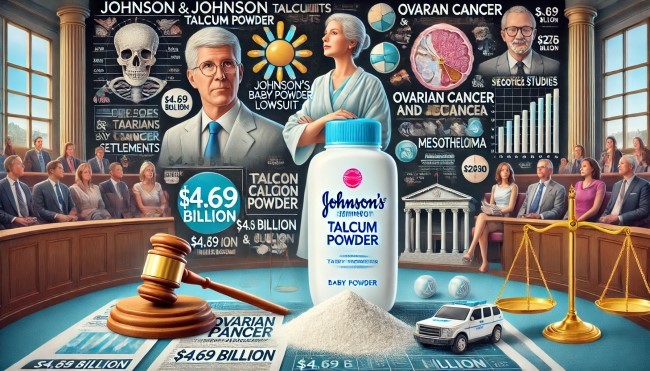Johnson & Johnson Talcum Powder Lawsuits: Justice and Accountability
Uncovering the Truth: A Comprehensive Guide to the Ongoing Legal Battle

Due to their severe health implications and high-profile nature, the Johnson & Johnson talcum powder lawsuits have captured significant attention worldwide. These lawsuits allege that Johnson & Johnson’s talcum powder products, including the widely used Johnson’s® Baby Powder, caused ovarian cancer and mesothelioma in thousands of women. The legal battles have been extended and complex, involving substantial settlements and significant public interest. This article aims to provide a detailed and comprehensive overview of these lawsuits, their impact, and the ongoing quest for justice and accountability.
The Genesis of the Lawsuits
Early Concerns and Initial Lawsuits
The concerns surrounding Johnson & Johnson’s talcum powder products date back to the mid-20th century when initial studies indicated the presence of asbestos, a known carcinogen, in talc. The first major lawsuit was filed in 2009 by Deane Berg, who alleged that her ovarian cancer was caused by prolonged use of Johnson’s Baby Powder. Although she won her case, the jury did not award damages. This case set the stage for many more to follow.
The Rise of Litigation
By 2016, the litigation had gained significant momentum. A notable case in St. Louis, Missouri, resulted in a jury awarding $72 million to the family of Jacqueline Fox, who died of ovarian cancer. This verdict included compensatory and punitive damages, highlighting the jury’s intent to send a solid message to Johnson & Johnson about the severity of their negligence.
Scientific Evidence and Health Implications
Studies Linking Talc to Cancer
Multiple scientific studies have played a crucial role in these lawsuits. In May 2024, a pivotal study published in the Journal of Clinical Oncology linked talc use to ovarian cancer, reinforcing the claims of thousands of plaintiffs. These studies have been instrumental in court cases, providing evidence to support claims of harm caused by talc-based products.
Health Risks of Asbestos-Contaminated Talc
Asbestos, a naturally occurring mineral, is a potent carcinogen. When talc is mined, it can be contaminated with asbestos. The inhalation of asbestos fibres can lead to mesothelioma, a rare and aggressive cancer. Asbestos in Johnson & Johnson’s talcum powder has been a focal point in many lawsuits, with plaintiffs arguing that the company failed to adequately warn consumers about this risk.
Legal Developments and Major Verdicts
Landmark Cases and Settlements
Several landmark cases have shaped the course of the Johnson & Johnson talcum powder lawsuits:
- June 2018: A jury awarded $4.69 billion to 22 women with ovarian cancer, one of the largest payouts in the history of these lawsuits.
- June 2024: An Oregon jury ordered Johnson & Johnson to pay $260 million to Kyung Lee, who developed mesothelioma from using the company’s baby powder.
Multidistrict Litigation (MDL)
Many cases have been consolidated into multidistrict litigation (MDL) in New Jersey to manage many lawsuits efficiently. As of May 2024, 53,950 cases were pending in this MDL. The MDL process allows for streamlined pretrial proceedings and helps manage the complex discovery processes involved in these cases.
Bankruptcy and Settlement Proposals
The Controversial Bankruptcy Strategy
Johnson & Johnson created a subsidiary, LTL Management, to manage its legal liabilities, which then filed for bankruptcy. This strategy, often called the “Texas two-step,” aimed to channel the company’s talc liabilities into the subsidiary, allowing Johnson & Johnson to continue its operations while LTL Management handled the settlements. However, this move has faced significant legal challenges, with courts twice rejecting the bankruptcy filings.
Settlement Offers
Despite these setbacks, Johnson & Johnson has made several settlement offers. In May 2024, the company proposed a $6.48 billion settlement to resolve thousands of lawsuits. This offer, spanning 25 years, is intended to cover current and future claims. While some plaintiffs have accepted these offers, others argue that the settlements are insufficient to cover the long-term health implications and associated costs.
State Settlements and Deceptive Marketing Claims
State-Level Settlements
In addition to individual lawsuits, Johnson & Johnson has faced legal action from several states. In January 2024, the company reached a $700 million settlement with 42 states and the District of Columbia over allegations of deceptive marketing practices. This settlement, however, does not impact the ongoing individual lawsuits.
The Impact of State Settlements
State settlements often set precedents for future litigation and can influence the strategies of both plaintiffs and defendants. These settlements also highlight the broader regulatory and ethical concerns surrounding the marketing and safety of consumer products.
The Human Impact
Stories of Plaintiffs
The plaintiffs’ stories in these lawsuits underscore the human toll of corporate negligence. Women like Jacqueline Fox, Kyung Lee, and many others have bravely come forward to share their experiences and seek justice. Their stories highlight the devastating impact of cancer on their lives and families and the ongoing fight for accountability.
Advocacy and Awareness
These lawsuits have also spurred increased advocacy and awareness efforts. Organizations dedicated to cancer research and consumer safety have amplified their calls for stricter regulations and better consumer protections. The cases have also encouraged more rigorous scientific research into the health impacts of consumer products.
Looking Ahead
The Future of Talcum Powder Litigation
The future of talcum powder litigation remains uncertain. With ongoing legal battles and potential new claims emerging, Johnson & Johnson faces significant challenges. The outcomes of these cases will likely have broader implications for corporate accountability and consumer safety.
Potential Reforms
The lawsuits have highlighted the need for potential reforms in how consumer products are regulated and marketed. There is a growing call for more transparent and stringent safety testing, more explicit labelling, and better regulatory oversight to prevent similar issues in the future.
Conclusion
The Johnson & Johnson talcum powder lawsuits represent a significant chapter in consumer safety and corporate accountability history. As the legal battles continue, the plaintiffs’ stories and the scientific evidence presented will be crucial in shaping the outcomes. These cases serve as a stark reminder of the importance of rigorous safety standards and the need for corporations to prioritize the health and well-being of their consumers over profits. The pursuit of justice in these cases underscores the ongoing fight for accountability and the protection of public health.



